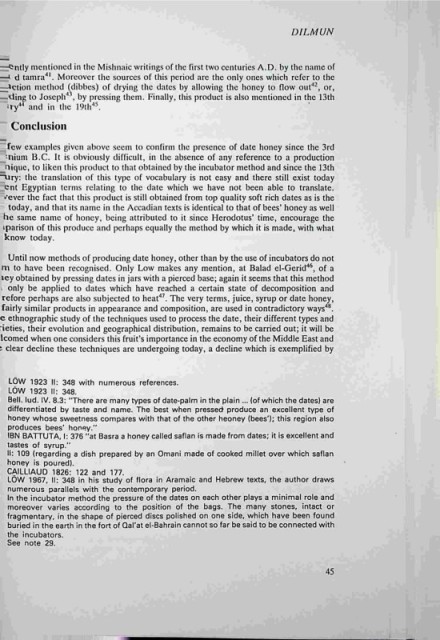Page 76 - DILMUN 13_Neat
P. 76
DILMUN
ntly mentioncd in the Mishnaic writings of thc first two ccnturies ٨٠.D. by the na١١e of
ﺍdtamr'٨ Moreover the sources of this period ar٥ the only ones which rcfer to the
action mcthod (dibbes) of drying the datcs by allowing the honey to lfow on1?٤, or,
ding to osepﺍr٩ﺑ, ﻦpressing then. Finally, thiis produc ﺁis also mentioncd in the 13ًth
ty" nd in th١e 19١,'5.
Conclusion
ﺱfe٧ xamples givcn above sccm to confirn the presence of date honey since the 3rd
٨n١ ؟B.C. It is obviously difficult, in thc abscnce of any reference to a production
nique, to liken this product to that obtained by the incubator method and since the 13th
ﻷ
ury: the transltion of this type of vocabulary is not casy and there still exist today
ent Egyptian tcrns relati٠ng to the date which we have not been able to translate.
vever the fact that this product is still obtained from top quality soft rich dates as is the
today, and that its name in the Accadian texts is identical to that of bees' honey as well
he same name of honcy, being attributed to it since Herodotus' time, encourage the
parison of this produce and perhaps equally the mcthod by which it is made, with what
know today.
Until now mcthods of producing date honey, other than by the use of incubators do not
m to have been recognised. Only Low makes any mention, at Balad el-Gerid6, ٥f a
ey obtained by pressing dates in jars with a pierced base; again it scems that this methodﺍ
١ only be applied to dates which have reached a certain state of decomposition and
refore perhaps are also subjected to heat7. The very terms, juice, syrup or date honey,
fairly similar products in appearance and composition, are used in contradictory ways9
e ethnographic study of the techniques used to process the date, their different types and
rieties, their evolution and geographical distribution, remains to be carried out; it will be
lcomed when one considers this fruit's importance in the economy of the Middle East and
> clear decline these techniques are undergoing today, a decline which is exemplified by
LOw ٦923 ١١: 348 with numerous references.
t5w 1923 1١: 348.
Bell. lud. ١٧. 8.3: "Tere are many ytpes of date-palm in the plain .٠٠ (of which the dates) are
differentiated by taste and name. The best when pressed produce an excellent type of
honey whose sweetness compares with that of the other heoney (bees'); this region also
produces bees' honey."
١BN BATTUTA,١: 376 "a٤ Basra a honey called saflan is made from dates; it is excellent and
tastes of syrup."
١١: 109 (regarding a dish prepared by an Omani made of cooked millet over which saflan
honey is poured).
CAILLIAUD 1826: 122 and 17٦.
LOw 1967, ١١: 348 in his study of flora in Aramaic and Hebrew texts, the author draws
numerous parallels with the contemporayr period.
ln the incubator method the pressure of the dates on each other plays a minimal role and
moreover varies according to the position of the bags. The many stones, intact or
fragmentary, in the shape of pierced discs polished on one side, which have been found
buried in the eatrh in the fotr of Oal'at el-Bahrain cannot so far be said to be connected with
the incubators.
See note 29.
45

